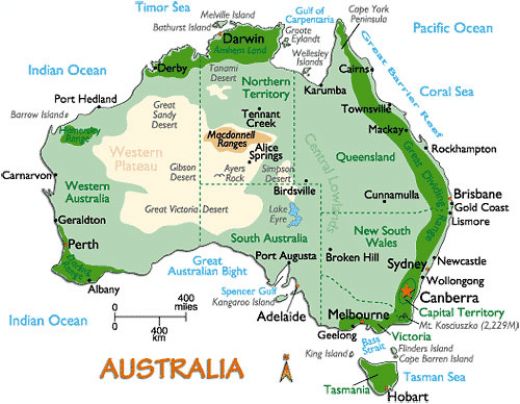
- •Английский язык Australia
- •Content
- •Geography and climate
- •Australia’s past
- •National flag of australia
- •Australian National Flag Day
- •Coat of arms
- •1912 Commonwealth Coat of Arms
- •1912 Commonwealth Coat of Arms
- •Description of the 1912 Commonwealth Coat of Arms
- •Australia’s floral emblem
- •Aboriginal australia
- •Political system
- •Australian cities
- •Canberra
- •Melbourne
- •Landmarks
- •Australian universities
- •Flora and fauna
- •Festivals and events in australia
- •Adventure sports in australia
- •Anzac Day -Dawn Service
- •Melbourne cup
- •Eating habits Asian Food. Australian’s Favorites. Bush Tucker. Modern Cuisine.
- •Famous australians
- •Ned Kelly - Such Is life
- •Burke and Wills - The Great Explorers
- •Phar Lap - The Loser Horse That Became a Champion
- •Banjo Patterson - The Bush Poet
- •Ian Thorpe
- •Fun Facts About Australia
- •614990. Пермь, ул. Букирева, 15
ФЕДЕРАЛЬНОЕ АГЕНТСТВО ПО ОБРАЗОВАНИЮ
Государственное образовательное учреждение
Высшего профессионального образования
«Пермский государственный университет»
Кафедра английского языка
профессиональной коммуникации
Английский язык Australia
Методический материал для формирования лингвострановедческой компетенции студентов неязыковых факультетов
Пермь 2010
Составители: преподаватели Катаева Е.Г., Полякова Н.Е.
Английский язык. Australia: методический материал для формирования лингвострановедческой компетенции студентов неязыковых факультетов. /cост. E.Г. Катаева, Н.Е. Полякова; Перм. гос. ун-т. – Пермь, 2010. 82 с. На англ. яз.
В настоящее пособие включены наиболее интересные и актуальные материалы о жизни Австралии, о ее политической системе, особенностях географического положения, государственного устройства, обычаях и традициях, спортивной жизни и культуре. Тексты снабжены вопросами для проверки понимания.
Методическое пособие адресовано студентам, изучающим английский язык для формирования лингвострановедческой компетенции.
Печатается по постановлению методической комиссии факультета современных иностранных языков и литератур
Пермского университета
©.Катаева Е.Г., Полякова Н.Е., составление, 2010
© Пермский государственный университет, 2010
Content
Geography and climate …………………………………………..4
Australia’s past …………………………………………………. .6
National flag of Australia………………………………………...7
Coat of arms…………………………………………………… .9
Australia’s floral emblem………………………………………..12
Aboriginal Australia……………………………………………..14
Political system ……………………………………………….....17
Australian cities ………………………………………………… 18
Canberra …………………………………………………………19
Sydney……………………………………………………………21
Melbourne ………………………………………………………. 23
Landmarks ……………………………………………………….25
Australian universities……………………………………………29
Flora and fauna …………………………………………………..31
Festivals and events in Australia…………………………………34
Adventure sports in Australia…………………………………….35
Australian traditions…………………………………………… 38
Eating habits ……………………………………………………..44
What are Australians like? …………………………………….....47
Famous Australians …………………………………………… 48
Steve Irwin ……………………………………………………… 48
Ned Kelly ……………………………………………………… 49
Burke and Wills ……………………………………………….....50
Phar Lap ………………………………………………………….51
Banjo Patterson …………………………………………………..51
Ian Thorpe ………………………………………………………..52
Fan facts about Australia ………………………………………...54
Geography and climate

Australia is considered to be the smallest of seven continents and the sixth biggest state. For the reason that it lies in the Southern Hemisphere, its seasons are the contrary of those in the northern part of the world. Australia is situated among the South Pacific Ocean and the Indian Ocean. It is made up of two islands. Australia is extremely close to other island nations. To the north are: Papa New Guinea, Indonesia and part of Malaysia. Additional to the north are the Philippines and Asian mainland. Southeast of Australia is called New Zealand. Like Australia, it was once a British settlement. At last, to the south is the frozen continent of Antarctica. Nearly half of Australia-the northern part of the county is situated in the earth's hot zone. Australia's tropical area is warm to hot during the whole year. Australia is the most droughty continent on the earth. About one half of its territory is occupied by deserts and semideserts. Most of them lie in the central and north-western part of the country. The Great Victoria Desert is the largest in Australia and the third largest in the world. The inland deserts can remain totally dry for years whilst rains can produce floods.
It is also the land of great plains. Only 6 percent of the island continent is above 2,000 feet (600 metres) in elevation. Its highest peak, Mount Kosciuszko, rises to only 7,310 feet (2,228 metres). Other rock structures in Australia are Uluru, Mount Augustus and Bald Rock.
The main part of Australia lies in tropics.
Australia is a continent that experiences a variety of climates due to its size. The weather can range from below zero temperatures in the Snowy Mountains to intolerable heat in the north-west. It is considered to be one of the driest continents on earth.
The damp season is November through April and the dried out season is May to October. The southern part of the country has a moderate type of weather. It has four separate seasons. Australia’s heaviest rains fall along the north, east and southeast coasts. The damp season brings aggressive rainstorms and cyclones on the north coast and floods farther inner part of the country. Droughts are regular all through much of Australia. Southwestern parts of the country are situated in subtropics. December, January and February are summer months in Australia. The average summer temperature there is from 20 to 30 degrees above zero. Winter comes in June, July and August. Then the average temperature is from 12 to 20 degrees above zero. Droughts are common in Australia.
The rainfall in the country is rather small. The largest rivers in Australia are the Darling and the Murray. In the middle part of Australia there are salt lakes, such as Lake Eyre and Torrence. Most Australian rivers are located near the coast. The largest and longest Australian rivers can be found in the eastern part of the country.
Why are the seasons in Australia contrary of those in the northern part of the world?
What is one half of the Australian territory occupied by?
Can you describe the relief of Australia?
What type of climate does the country have?
Are there any rivers in Australia? What are these?
